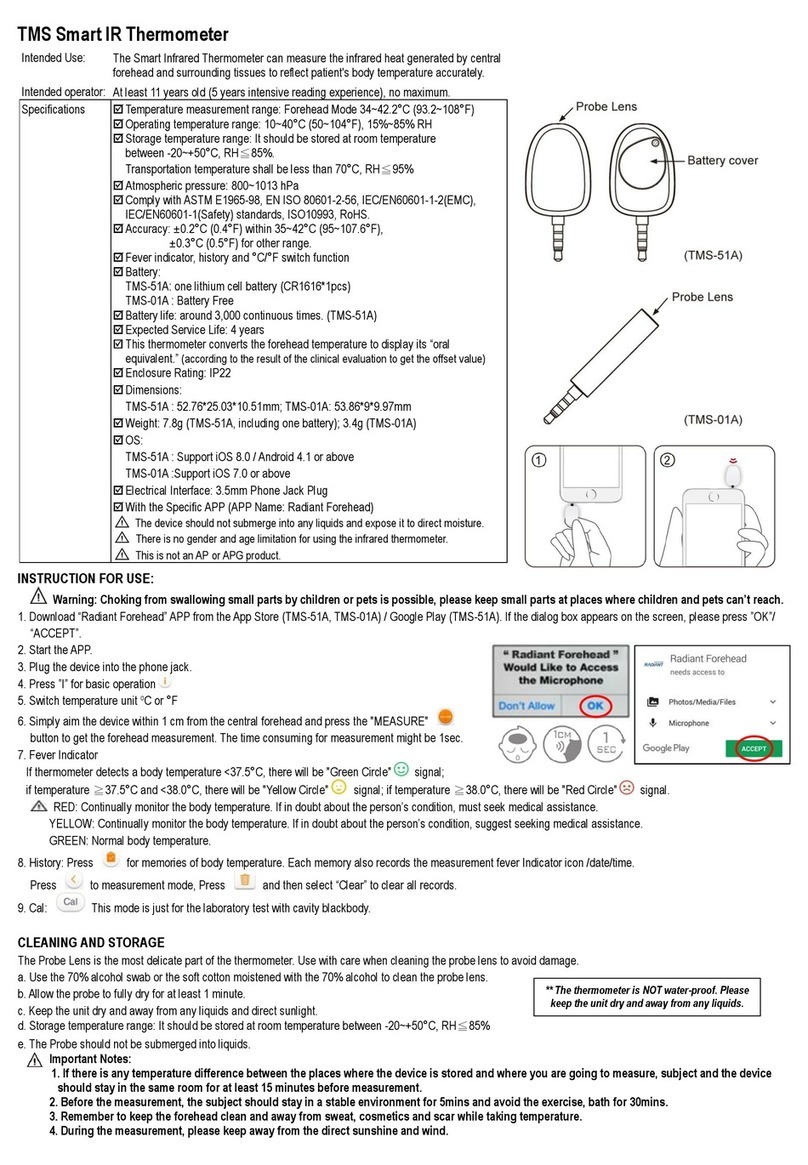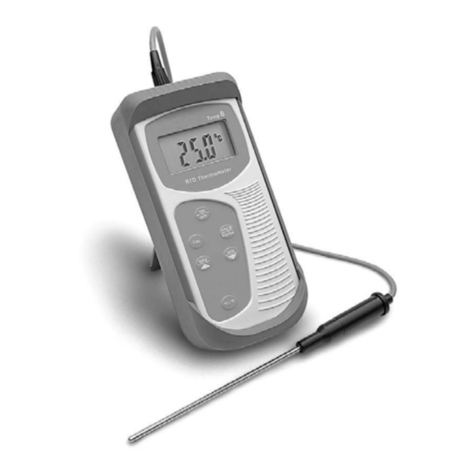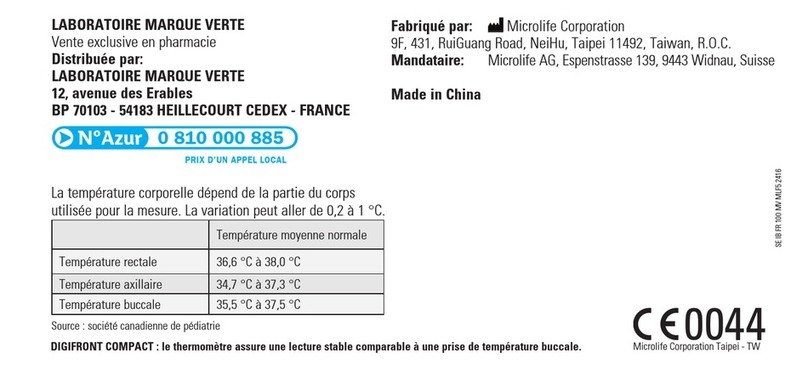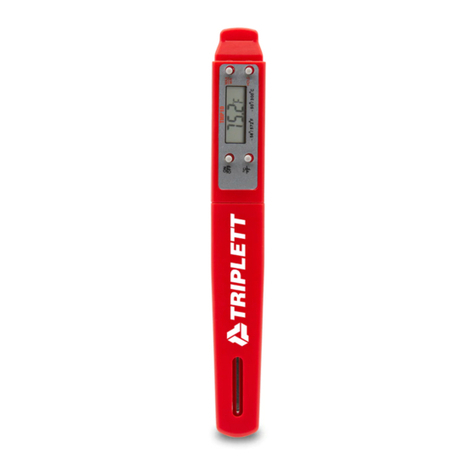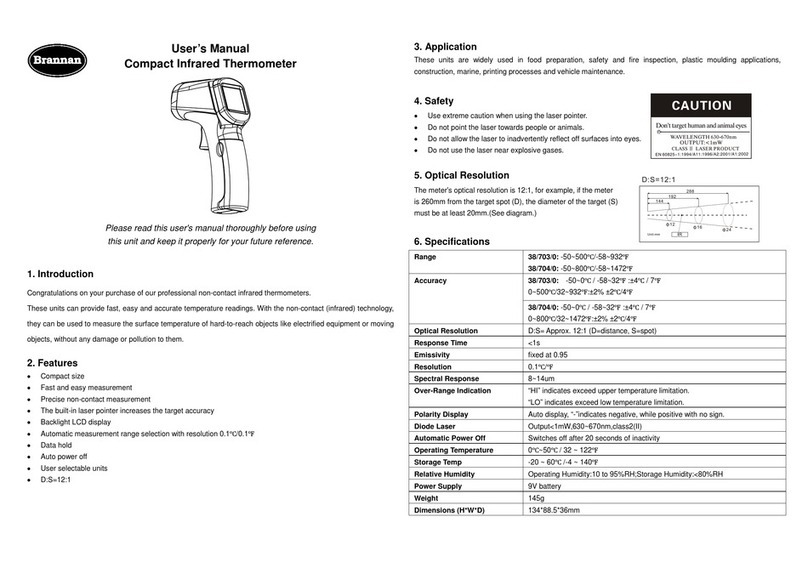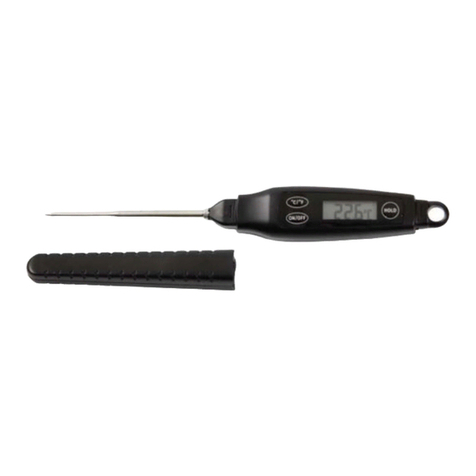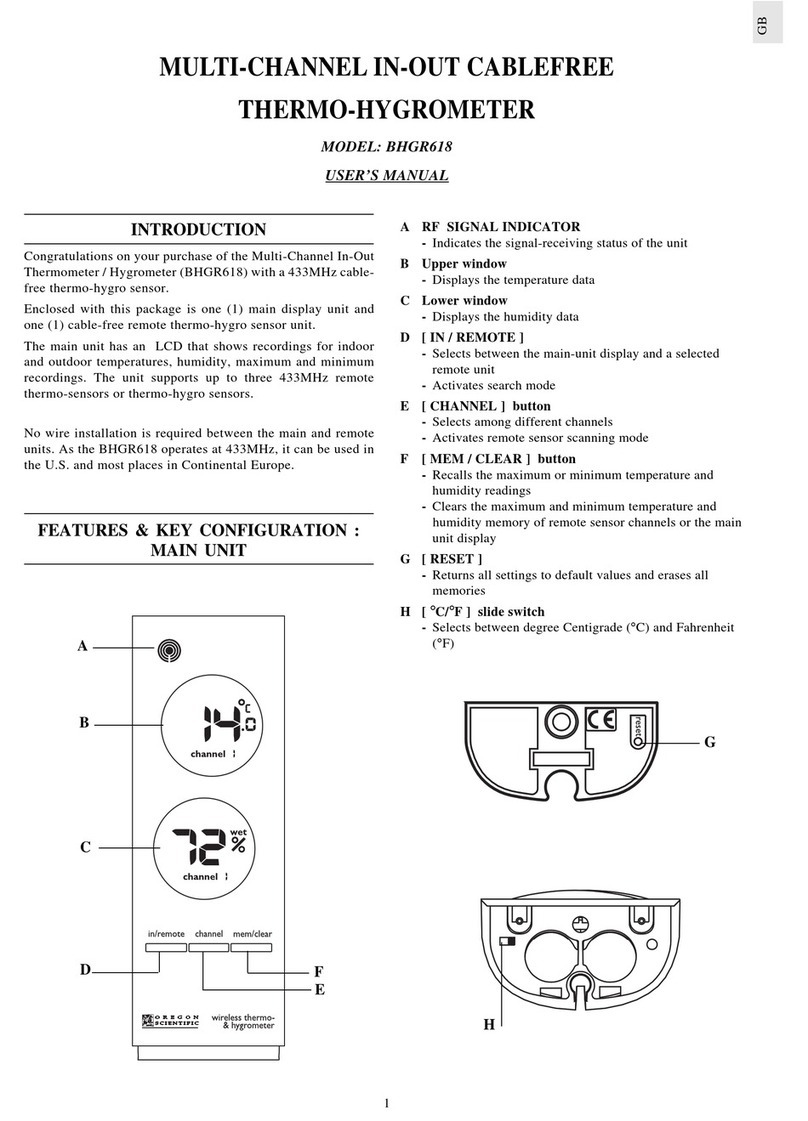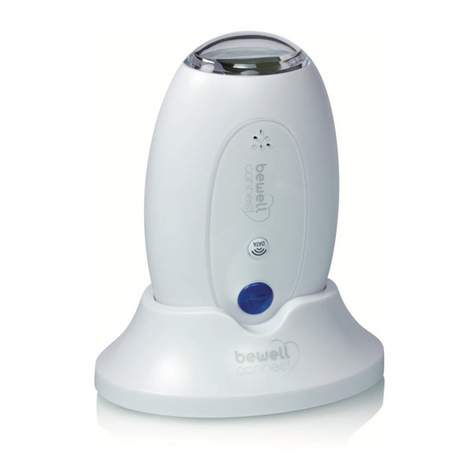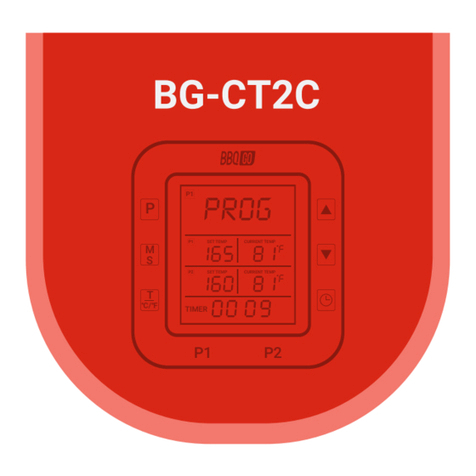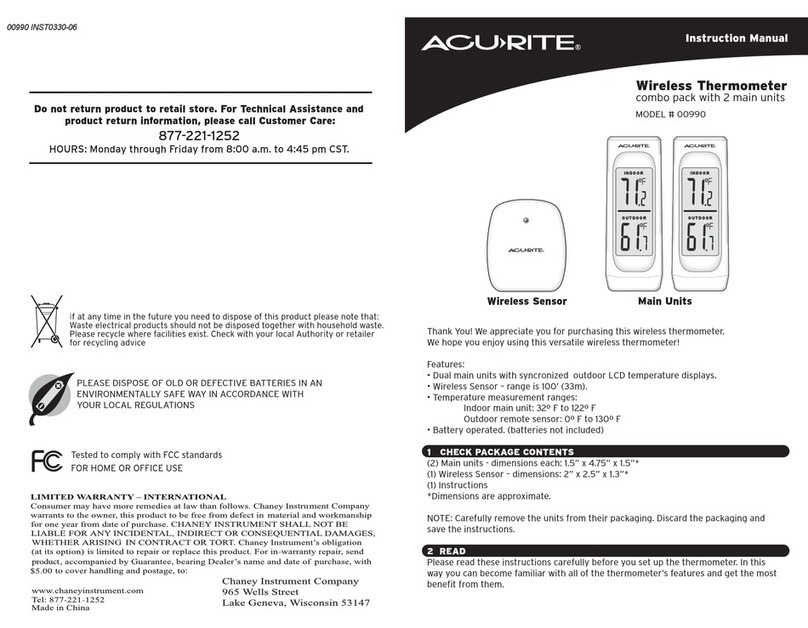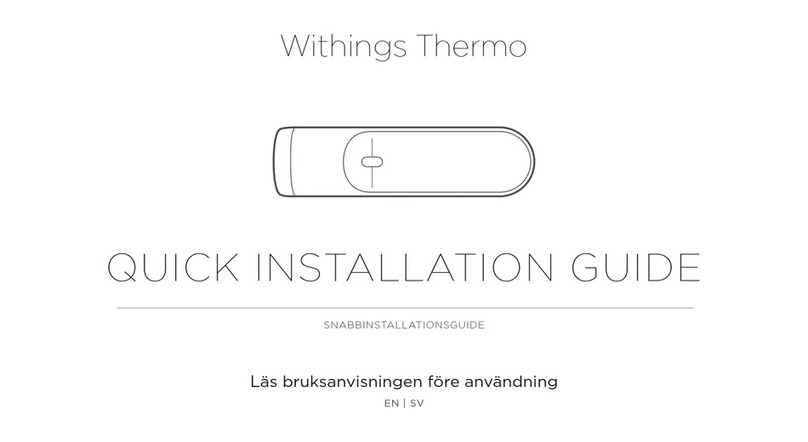Delta OHM HD2328 User manual

Our instruments' quality level is the results of the product continuous development. This
can bring about differences between the information written in this manual and the
instrument that you have purchased. We cannot entirely exclude errors in the manual, for
which we apologize.
The data, figures and descriptions contained in this manual cannot be legally asserted. We
reserve the right to make changes and corrections without prior notice.
HD2328.0
THERMOCOUPLE
THERMOMETER
ENGLISH
REV. 1.4
Mar.
,
30th 2007

- -
2
Thermocouple Thermometer
HD2328

- -
3
HD2328.0
1. Inputs A and B for two thermocouples, with standard miniature connectors.
2. Battery symbol: displays the battery charge level.
3. Function indicators.
4. Secondary display line.
5. DATA/ENTER key: during normal operation displays the maximum (MAX), the minimum
(MIN) and the average (AVG) of current measurements; in the menu, confirms the current
selection.
6. CLR/ESC key: during normal operation resets the maximum, the minimum and the average of
current measurements; in the menu, it resets the value set with the arrows.
7. HOLD/key: freezes the measurement display during normal operation; in the menu,
increases the current value.
8. A-B/MENU key: during normal operation, it displays in the secondary line the difference of the
temperatures measured by the probes connected to the inputs A and B; when pressed together
with the DATA key, it allows to open the menu.
9. REL/key: during normal operation enables the relative measurement (displays the difference
between the current value and the logged value when the key is pressed); in the menu, decreases
the current value.
10. ON-OFF/AUTO-OFF key: turns the instrument on and off; when pressed together with the
HOLD key, disables the AutoPowerOff function.
11. MAX (maximum value), MIN (minimum value) and AVG (average value) symbols.
12. Main display line.
13. Line for symbols and comments.

- -
4
TABLE OF CONTENTS
1. GENERAL CHARACTERISTICS............................................................................................................................. 5
2. DESCRIPTION OF THE FUNCTIONS .................................................................................................................... 6
3. THE PROGRAMMING MENU ................................................................................................................................. 9
4. PROBES AND MEASUREMENTS.......................................................................................................................... 10
4.1 TEMPERATURE MEASUREMENT .............................................................................................................................. 10
4.2 CALIBRATION OF THE INSTRUMENT ON LINE WITH THE PROBE(S)............................................................................ 10
4.2.1 Calibration sequence ...................................................................................................................................... 11
5. WARNINGS................................................................................................................................................................ 12
6. INSTRUMENT SIGNALS AND FAULTS .............................................................................................................. 13
7. LOW BATTERY WARNING AND BATTERY REPLACEMENT ..................................................................... 14
7.1 WARNING ABOUT BATTERY USE.............................................................................................................................. 14
8. INSTRUMENT STORAGE....................................................................................................................................... 15
9. NOTES ABOUT WORKING AND OPERATIVE SAFETY ................................................................................. 16
10. TECHNICAL CHARACTERISTICS .................................................................................................................... 17
11. ORDER CODES ....................................................................................................................................................... 19
11.1 THERMOCOUPLE PROBES....................................................................................................................................... 19

- -
5
1. GENERAL CHARACTERISTICS
The Thermocouple Thermometer Model HD2328.0 is a portable instrument with two inputs A and
B. It measures the temperature of the two input channels, and can calculate the difference between
the two channels (A-B).
It is fitted with a large LCD display for excellent visualization of the measured data. The
Thermometer Model HD2328.0 measures the temperature using immersion, penetration, contact or
air probes.
The sensor can be a thermocouple chosen among the following types:
•Type K
•Type J
•Type T
•Type E
The instrument accepts the input of one, or two, thermocouples of the same type (K-J-T-E) even in
a different form.
The units of measurement are the following:
1. °C (Celsius degrees)
2. °F (Fahrenheit degrees).
Using the Max, Min and Avg function of this instrument respectively obtains also the maximum,
minimum or average values.
Other available functions are:
•the relative measurement REL;
•the HOLD function;
•the A-B function;
•the automatic turning off which can also be disabled.
See chapter 2 for further information.
The instrument is provided with the factory calibration. It is also possible to perform a "User
Calibration" of instrument+probe (see chapters 3 and 4).

- -
6
2. DESCRIPTION OF THE FUNCTIONS
The keyboard of the Thermocouple Thermometer Model HD2328.0 is composed of double-
function keys. The function on the key is the "main function", while the one above the key is the
"secondary function".
When the instrument is in standard measurement mode, the main function is active.
In the menu, the secondary function is enabled; press the DATA+(A-B) keys together to open the
menu.
The pressing of a key is accompanied by a short confirmation "beep": a longer "beep" sounds if the
wrong key is pressed. Each key specific function is described in detail below.
The HD2328.0 measures the temperature at the two inputs: the temperature measurement at the "A"
input is displayed in the main line, while the secondary line shows the value at the "B" input.
This key has two functions:
•ON/OFF: to turn the instrument on press ON, to turn it off press OFF.
The turning on enables all display segments for a few seconds, and then the type of calibration
enabled (CAL FACT = factory calibration; CAL USER = user calibration).
•AUTO/OFF: the AutoPowerOff function can be disabled by simultaneously pressing this key
and the "HOLD" key when turning the instrument on.
If no probe is connected to one of the input connectors, the "BURN" message appears in the
corresponding line, that is, in the first line for input "A" and in the second line for input "B".
The instrument has an AutoPowerOff function that automatically turns the instrument off after about
8 minutes if no key is pressed during the intervening time.
Press simultaneously the ON/OFF key and the HOLD key to disable this function.
In this case, remember to turn the instrument off using the ON/OFF key: disabling of the automatic
turning off is shown by the blinking battery symbol.
ON-OFF and AUTO-OFF key
Disabling of the automatic turning off

- -
7
The DATA key is used for the following functions:
•DATA: during normal measurement, by pressing this key once the maximum (MAX) value of
the measurements captured by the probes connected to the instrument is displayed, updating it
with the acquisition of new samples;
-by pressing this key again the minimum (MIN) value is displayed;
-by pressing this key a third time the average (AVG) value is displayed.
The acquisition frequency is once a second.
The MAX, MIN and AVG values remain in the memory until the instrument is on, even after
exiting the DATA display function. When the instrument is off, the previously memorized data
are cleared. Upon turning on, the instrument automatically starts memorizing the MAX, MIN
and AVG values.
To reset the previous values and start with a new measurement session, press CLR until the
FUNC_CLRD message appears.
•ENTER: once the MENU has been opened with the DATA+UNIT keys, the DATA key will
perform the ENTER function and the MENU can be browsed and the displayed parameter
confirmed.
The CLR key has two functions:
•CLEAR (CLR): allows to reset the maximum (MAX), minimum (MIN) and average (AVG)
value of the captured measurements;
•ESC: once the MENU has been opened with the DATA+UNIT keys, the CLR key will allow
to cancel the parameters set using the and arrows.
The HOLD key is used for the following functions:
•HOLD: by pressing this key the current measurement update is stopped and the "HOLD"
message will appear in the upper left-hand corner of the display. To return to the current
measurement, press the key again.
•: once the MENU has been opened with the DATA+UNIT keys, the key will allow to
increase the value of the selected parameter.
Pressed together with the ON/OFF key, during turn on, the AutoPowerOff function is disabled (see
the description of the ON/OFF key).
DATA/ENTER key
CLR/ESC key
HOLD/key

- -
8
The A-B key is used for the following functions:
•A-B: in measurement mode, it displays in the secondary line the difference of the temperatures
measured by the probes connected to the inputs Aand B, and indicates "ERR" if one of the
probes is in error (not connected, faulty or overrange). To end the function, press the key again.
•MENU: in the menu three items can be set (see chapter 3):
1. Selection of the unit of measurement for temperature: °C or °F.
2. Selection of the type of Thermocouple: K, J, T, E.
3. Starting the User calibration procedure.
-the menu is opened by pressing simultaneously DATA+(A-B): the first item of the instrument
programming menu will appear;
-use the and arrows (respectively located above the HOLD and REL keys) to modify the
displayed value;
-press DATA/ENTER to confirm the modification and go onto the next item;
-press CLR/ESC to cancel the modification;
-to exit the menu, press the A-B/MENU key again.
The REL key is used for the following functions:
•REL: it displays the difference between the current value and that measured on pressing the key
for both measurements: main and secondary. The "REL" message is displayed on the left. To
return to the normal measurement, press the key again.
•: once the MENU has been opened with the DATA+(A-B) keys, the key will allow to
decrease the value of the selected parameter.
REL/key
A-B/MENU key

- -
9
3. THE PROGRAMMING MENU
To access to the programming menu press simultaneously the DATA+(A-B) keys.
The items to be set are listed in this order:
1. Selection of the unit of measurement: the "SEL_MEAS_UNIT" message is displayed in
the comment line. The main line in the center of the display shows the selected unit of
measurement: Celsius (°C) or Fahrenheit (°F) degrees.
-use the and arrows (respectively located above the HOLD and REL keys) to modify
the type of probe;
-press DATA/ENTER to confirm the modification and go onto the next item;
-press CLR/ESC to cancel the modification;
-to exit the menu, press the A-B/MENU key again.
2. Selection of the type of Thermocouple: the "SEL" message is displayed in the main line,
while the type of probe is displayed in the comment line; in the secondary line is shown the
"tc" message.
The types of thermocouple that can be selected are: K, J, T, or E.
-use the and arrows (respectively located above the HOLD and REL keys) to modify
the type of thermocouple;
-press DATA/ENTER to confirm the modification and go onto the next item;
-press CLR/ESC to cancel the modification;
-to exit the menu, press the A-B/MENU key again.
3. Starting the User calibration procedure: the "CAL_MODE" message is displayed in the
comment line, and "FACt" is displayed in the main line.
The instrument is provided with the factory ("FACt") calibration. It is also possible to
perform a "USER calibration" ("USEr")of instrument+probe. The calibration information is
saved in the instrument's memory. The same correction is applied to any probe connected to
the input: therefore the "USER calibration" should only be used with the probe used for
calibration and not with other probes.
-use the and arrows (respectively located above the HOLD and REL keys) and select
USEr, to access the "User Calibration" procedure;
-press DATA/ENTER to confirm the modification;
-the "SEL_CHAN" message is displayed in the comment line;
-use the and arrows (respectively located above the HOLD and REL keys) to select the
input "A" or "B" in the main line;
-press DATA/ENTER to confirm the modification;
-the "SEL_MEAS_1/2" message is displayed in the comment line;
-use the and arrows (respectively located above the HOLD and REL keys) to select
"0", "1" or "2" in the main line;
-press DATA/ENTER to confirm the modification;
-press CLR/ESC to cancel the modification;
-to exit the menu, press the A-B/MENU key again.
See chapter 4 for further explanations.

- -
10
4. PROBES AND MEASUREMENTS
The instrument works with thermocouple probes of type K, J, T, or E.
See chapter 3 for the selection of the type of probe.
The contacts of the thermocouple probe connector are polarized. They must be inserted on the
standard miniature socket located on the instrument in the correct direction. These probes are
usually marked with a "+" and "–" sign.
The user can choose the unit of measurement for display of temperature: °C and °F.
The Thermometer HD2328.0 has two inputs: the temperature for input "A" (see description of the
inputs) is displayed in the main line: the temperature for input "B" is displayed in the secondary
line. When the "A-B" function is enabled, the relevant differential temperature is displayed in the
secondary line.
If two probes are used, they must be the same type of thermocouple.
4.1 TEMPERATURE MEASUREMENT
In all versions the thermocouple hot junction is housed in the end part of the probe.
The response time for the measurement of the temperature in air is greatly reduced if the air is
moving. If the air is still, stir the probe. The response times are longer than those for liquid
measurements.
The temperature measured by immersion is carried out by inserting the probe in the liquid, in the
oven where you wish to perform the measurement; the hot junction is housed in the end part of the
probe.
In the temperature measured by penetration the probe tip must be inserted into the material; the hot
junction is housed in the end part of the probe.
NOTE: when measuring the temperature on frozen blocks it is convenient to use a mechanical tool
to bore a cavity in which to insert the tip probe.
In order to perform a correct contact measurement, the measurement surface must be even and
smooth, and the probe must be perpendicular to the measurement plane.
So as to obtain the correct measurement, the insertion of a drop of oil or heat-conductive
paste between the surface and the probe is useful (do not use water or solvents). This method
also improves the response time.
4.2 CALIBRATION OF THE INSTRUMENT ON LINE WITH THE PROBE(S)
To calibrate the probes correctly, a knowledge of and abiding by the physical phenomena on which
the measurement is based is fundamental: this is the reason why it is recommended to abide by what
is reported below carefully, and only to perform new calibrations if technically proficient and using
the suitable equipment.
The instrument is provided with the only FACT (factory) calibration.
The user is also able to perform a USER calibration of instrument+probe.

- -
11
The calibration information is saved in the instrument's memory. The same correction is applied to
any probe that is subsequently connected to the input: therefore the "USER calibration" should only
be used with the probe used for calibration and not with other probes.
To pass from the user to the factory calibration and back, proceed as follows (see also the menu
description in chapter 3):
•press simultaneously (A-B)/MENU and DATA/ENTER to open the menu:
•press ENTER until the menu item "CAL_MODE" is selected;
•use the and arrows (respectively located above the HOLD and REL keys) to select the
type of calibration, FACT or USER;
•confirm by pressing DATA/ENTER.
4.2.1 Calibration sequence
Instrument on line with the probe(s)
The calibration can be carried out on one or two points that should differ by at least 10°C and be
included in the probe functioning range.
1. Insert the probe into a thermostatic bath, the temperature of which is precisely known from a
reading taken on a sample reference thermometer. Wait for the measurement to stabilize.
2. Press simultaneously (A-B)/MENU and DATA/ENTER to open the menu.
3. Press DATA/ENTER until the menu item "CAL_MODE" is selected.
4. Use the and arrows (respectively located above the HOLD and REL keys) to select the
USER calibration.
5. Confirm with DATA/ENTER.
6. Use the and arrows (respectively located above the HOLD and REL keys) to select the
input to which the probe being calibrated is connected, choosing the upper connector A or the
lower one B.
7. Confirm with DATA/ENTER.
8. The "SEL_MEAS_1/2" message is displayed in the comment line.
9. Use the and arrows to select "1" (first calibration point).
10. Confirm with DATA/ENTER.
11. The "UP DOWN 1st MEAS" message is displayed in the comment line: the instrument display
shows the measured temperature.
12. Use the and arrows to correct the indicated value until it coincides with the value
measured by the sample reference thermometer.
13. Confirm with DATA/ENTER.
14. To exit the procedure without performing the second point, select "0" and press ENTER.
15. To calibrate the second point, select the point "2" using the and arrows.
16. Press DATA/ENTER.
17. The "UP DOWN 2nd MEAS" message is displayed in the comment line.
18. Move the probe to the second thermostatic bath and wait for the measurement to stabilize.
19. The instrument display shows the measured temperature.
20. Use the and arrows to correct the indicated value until it coincides with the value
measured by the sample reference thermometer.
21. Confirm with DATA/ENTER.
The procedure is now complete.

- -
12
5. WARNINGS
1. Do not expose the probes to gases or liquids that could corrode the material of the probe. Clean
the probe carefully after each measurement.
2. Do not bend the probe connectors or force them upward or downward.
3. Comply with the correct polarity of the probes.
4. Do not bend or force the contacts when inserting the probe connector into the instrument.
5. Do not bend, deform or drop the probes, as this could cause irreparable damage.
6. Always select the most suitable probe for your application.
7. In general, do not use temperature probes in presence of corrosive gases or liquids; the probe
external containers are made of AISI 316 or INCONEL stainless steel, while the contact probe
containers are made from AISI 316 or INCONEL stainless steel plus silver. Avoid contact
between the probe surface and any sticky surface or product that could corrode or damage it.
8. To obtain reliable measurements, temperature variations that are too rapid must be avoided.
9. Temperature probes for surface measurements (contact probes) must be held perpendicular
against the surface. Apply oil or heat-conductive paste between the surface and the probe in
order to improve contact and reduce reading time. Whatever you do, do not use water or solvent
for this purpose. A contact measurement is always very hard to perform. It has high levels of
uncertainty and depends on the ability of the operator.
10. Temperature measurements on non-metal surfaces usually require a great deal of time due to the
low heat conductivity of non-metal materials.
11. The sensor is not insulated from its external casing; be very careful not to come into contact
with live parts (above 48V). This could be extremely dangerous for the instrument as
well as for the operator, who could be electrocuted.
12. Avoid taking measurements in presence of high frequency sources, microwave ovens or large
magnetic fields; results may not be very reliable.
13. The instrument is water resistant, but should not be immersed in water. Should the instrument
fall into the water, check for any water infiltration from the connectors' side. Gently handle the
instrument in such a way as to prevent any water infiltration from the connectors' side.

- -
13
6. INSTRUMENT SIGNALS AND FAULTS
The following table lists all error indications and information displayed by the instrument and
supplied to the user in different operating situations:
Display indications Explanation
1ST_MEAS UP DOWN Correct the first point using the arrows /
2ND_MEAS UP DOWN Correct the second point using the arrows /
BATT TOO LOW
CHNG NOW
Indication of insufficient battery charge appearing on turning on. The
instrument issues a long beep and turns off. Replace the batteries.
BURN The probe is disconnected or faulty.
CAL
LOST
Program error: it appears after turning on for a few seconds. Contact the
instrument's supplier.
CAL
FACT Factory calibration.
CAL
USER User calibration.
CAL_MODE Calibration mode
ERR
This message appears when a wrong function is called: for example,
should the A-B key be pressed or the AVG function be enabled when one
of the two probes is not connected.
FUNC CLRD Max, min and average values clearing
OVER
or
UNDR
Measurement overflow: indicates that the probe is measuring a value
exceeding the measuring range.
PLS_EXIT >>> FUNC
RES_FOR_FACT ONLY Please exit using ESC >>> function reserved to factory calibration
SEL CHAN Input channel selection
SEL MEAS 1/2 Select the first/second calibration point
SEL MEAS UNIT Selection of the unit of measurement
SEL_TYPE_TC Selection of the type of thermocouple
SYS
ERR
#
Instrument management program error. Contact the instrument's supplier
and communicate the numeric code # reported by the display.

- -
14
7. LOW BATTERY WARNING AND BATTERY REPLACEMENT
The battery symbol
on the display constantly shows the battery charge status. To the extent that batteries have
discharged, the symbol "empties". When the charge decreases still further it starts blinking.
In this case, batteries should be replaced as soon as possible.
If you continue to use it, the instrument can no longer ensure correct measurement. The memory
data are maintained.
If the battery charge level is insufficient, the following message appears when you turn the
instrument on:
BATT TOO LOW
CHNG NOW
The instrument issues a long beep and turns off. In this case, replace the batteries in order to
turn the instrument back on.
To replace the batteries, proceed as follows:
1. switch the instrument off;
2. unscrew the battery cover counter clockwise;
3. replace the batteries (3 1.5V alkaline batteries - type AA);
4. screw the cover on clockwise.
Malfunctioning upon turning on after battery replacement
After replacing the batteries, the instrument may not restart correctly; in this case, repeat the
operation.
After disconnecting the batteries, wait a few minutes in order to allow circuit condensers to
discharge completely; then reinsert the batteries.
7.1 WARNING ABOUT BATTERY USE
•Batteries should be removed when the instrument is not used for an extended time.
•Flat batteries must be replaced immediately.
•Avoid batteries leaking.
•Always use good quality leakproof alkaline batteries. Sometimes on the market, it is
possible to find new batteries with an insufficient charge capacity.

- -
15
8. INSTRUMENT STORAGE
Instrument storage conditions:
•Temperature: -25…+65°C.
•Humidity: less than 90%RH without condensation.
•Do not store the instrument in places where:
•humidity is high;
•the instrument may be exposed to direct sunlight;
•the instrument may be exposed to a source of high temperature;
•the instrument may be exposed to strong vibrations;
•the instrument may be exposed to steam, salt or any corrosive gas.
The instrument case is made of ABS plastic: do not use any incompatible solvent for cleaning.

- -
16
9. NOTES ABOUT WORKING AND OPERATIVE SAFETY
Authorized use
The technical specifications as given in chapter TECHNICAL CHARACTERISTICS must be
observed. Only the operation and running of the measuring instrument according to the instructions
given in this operating manual is authorized. Any other use is considered unauthorized.
General safety instructions
This measuring system is constructed and tested in compliance with the EN 61010-1 safety
regulations for electronic measuring instruments. It left the factory in a safe and secure technical
condition.
The smooth functioning and operational safety of the measuring system can only be guaranteed if
the generally applicable safety measures and the specific safety instructions in this operating
manual are followed during operation.
The smooth functioning and operational safety of the instrument can only be guaranteed under the
environmental and electrical operating conditions that are in specified in chapter TECHNICAL
CHARACTERISTICS.
Do not use or store the product in places such as listed below:
•Rapid changes in ambient temperature which may cause condensation.
•Corrosive or inflammable gases.
•Direct vibration or shock to the instrument.
•Excessive induction noise, static electricity, magnetic fields or noise.
If the measuring system was transported from a cold environment to a warm environment, the
formation of condensate can impair the functioning of the measuring system. In this event, wait
until the temperature of the measuring system reaches room temperature before putting the
measuring system back into operation.
Obligations of the purchaser
The purchaser of this measuring system must ensure that the following laws and guidelines are
observed when using dangerous substances:
EEC directives for protective labour legislation
National protective labour legislation
Safety regulations

- -
17
10. TECHNICAL CHARACTERISTICS
Instrument
Dimensions (Length x Width x Height) 140 x 88 x 38 mm
Weight 160g (complete with batteries)
Materials ABS
Display 2x4½ digits plus symbols
Visible area: 52 x 42 mm
Operating conditions
Operating temperature -5…50°C
Warehouse temperature -25…65°C
Working relative humidity 0…90%RH without condensation
Protection degree IP67
Power
Batteries 3 1.5V type AA batteries
Autonomy 200 hours with 1800mAh alkaline
batteries
Power absorbed with instrument off < 20μA
Connections
Inputs for probes 2-pole female polarized standard
miniature connectors
Unit of Measurement °C - °F;
Measurement of temperature by Instrument
Tc measurement range: K -200 … +1370°C
Tc measurement range: J -100 … +750°C
Tc measurement range: T -200 … +400°C
Tc measurement range: E -200 … +750°C
Resolution 0.1°C
Instrument accuracy
Thermocouple K ±0.1°C up to 600°C
±0.2°C over 600°C
Thermocouple J ±0.1°C up to 400°C
±0.2°C over 400°C
Thermocouple T ±0.1°C
Thermocouple E ±0.1°C up to 300°C
±0.2°C over 300°C
The precision only refers to the instrument. Error due to the thermocouple or to the cold
junction reference sensor is not included.
Temperature drift @20°C 0.02%/°C
Drift after 1 year 0.1°C/year

- -
18
Accuracy of the thermocouple probes:
The tolerance of a type of thermocouple corresponds to the maximum acceptable departure
from the e.m.f. of any thermocouple of that type, with reference junction at 0°C.
The tolerance is expressed in degrees Celsius, preceded by the sign.
The percentage tolerance is given by the ratio between the tolerance expressed in degrees
Celsius and the measurement junction temperature, multiplied by one hundred.
The thermocouples conforming to regulations must comply with one of the following
tolerance levels, the values of which are reported in the table.
G I (special tolerances)
G II (normal tolerances)
The tolerances refer to the expected thermocouple operating temperature, in agreement with
the thermoelements' diameter.
Tolerance of the thermocouples:
Type of
thermocouple Range °C G I* G II*
K 0 … +1370°C ±1.1°C or ±0.4% ±2.2°C or ±0.75%
J 0 … +750°C ±1.1°C or ±0.4% ±2.2°C or ±0.75%
T 0 … +400°C ±0.5°C or ±0.4% ±1°C or ±0.75%
E 0 … +750°C ±1°C or ±0.4% ±1.7°C or ±0.5%
K** -200 … 0°C --- ±2.2°C or ±2%
T** -200 … 0°C --- ±1°C or ±1.5%
E** -200 … 0°C --- ±1.7°C or ±1%
* The higher of the two optional limits is the valid one. Example: at 200°C the percentage
tolerance for type K thermocouple, tolerance G II, is ±0.75% and is equal to ±1.5°C.
Therefore, the limit of ±2.2°C is valid. On the other hand, at 600°C the percentage tolerance is
equal to ±4.5°C, and therefore this is the limit to use.
** The thermocouples that meet the limits for temperatures higher than 0°C do not necessarily
meet the limits for the range under 0°C.
EMC standard regulations
Security EN61000-4-2, EN61010-1 level 3
Electrostatic discharge EN61000-4-2 level 3
Electric fast transients EN61000-4-4 level 3,
EN61000-4-5 level 3
Voltage variations EN61000-4-11
Electromagnetic interference susceptibility IEC1000-4-3
Electromagnetic interference emission EN55020 class B

- -
19
11. ORDER CODES
HD2328.0 The kit is composed of the instrument HD2328.0 with two inputs, 3 1.5V alkaline
batteries, operating manual, and case. The probes must be ordered separately.
11.1 THERMOCOUPLE PROBES
The thermocouple probes can be connected to all instruments using the standard miniature
connector, which can be obtained from the price list.

- -
20
GUARANTEE
GUARANTEE CONDITIONS
All DELTA OHM instruments have been subjected to strict tests and are guaranteed for 24 months from
date of purchase. DELTA OHM will repair or replace free of charge any parts which it considers to be
inefficient within the guarantee period. Complete replacement is excluded and no request of damages are
recognized. The guarantee does not include accidental breakages due to transport, neglect, incorrect use,
incorrect connection to voltage different from the contemplated for the instrument. Furthermore the
guarantee is not valid if the instrument has been repaired or tampered by unauthorized third parties. The
instrument has to be sent to the retailer without transport charge. For all disputes the competent court is
the Court of Padua.
The electric and electronic devices with the following symbol cannot be disposed in the public
dumps. According to the Directive UE 2002/96/EC, the European users of electric and electronic
devices are allowed to give back to the Distributor or Manufacturer the used device at the time of
purchasing a new one. The illegal disposing of electric and electronic devices is punished by a
pecuniary administrative penalty.
This guarantee must be sent together with the instrument to our service centre.
N.B.: Guarantee is valid only if coupon has been correctly filled in all details.
Instrument type HD2328.0
Serial number
RENEWALS
Date Date
Inspector Inspector
Date Date
Inspector Inspector
Date Date
Inspector Inspector
CE CONFORMITY
Safet
y
EN61000-4-2, EN61010-1 LEVEL 3
Electrostatic discharge EN61000-4-2 LEVEL 3
Electric fast transients EN61000-4-4 LEVEL 3
Voltage variations EN61000-4-11
Electromagnetic interference susceptibility IEC1000-4-3
Electromagnetic interference emission EN55020 class B
Table of contents
Other Delta OHM Thermometer manuals
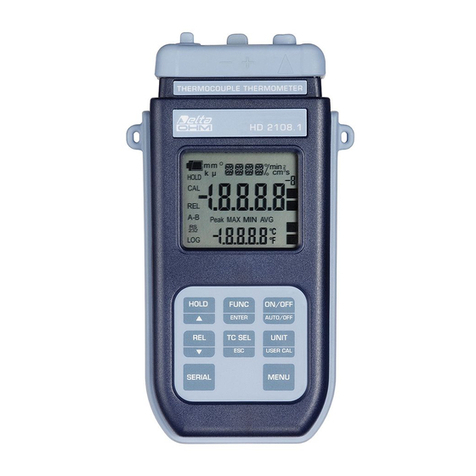
Delta OHM
Delta OHM HD2108.1 User manual
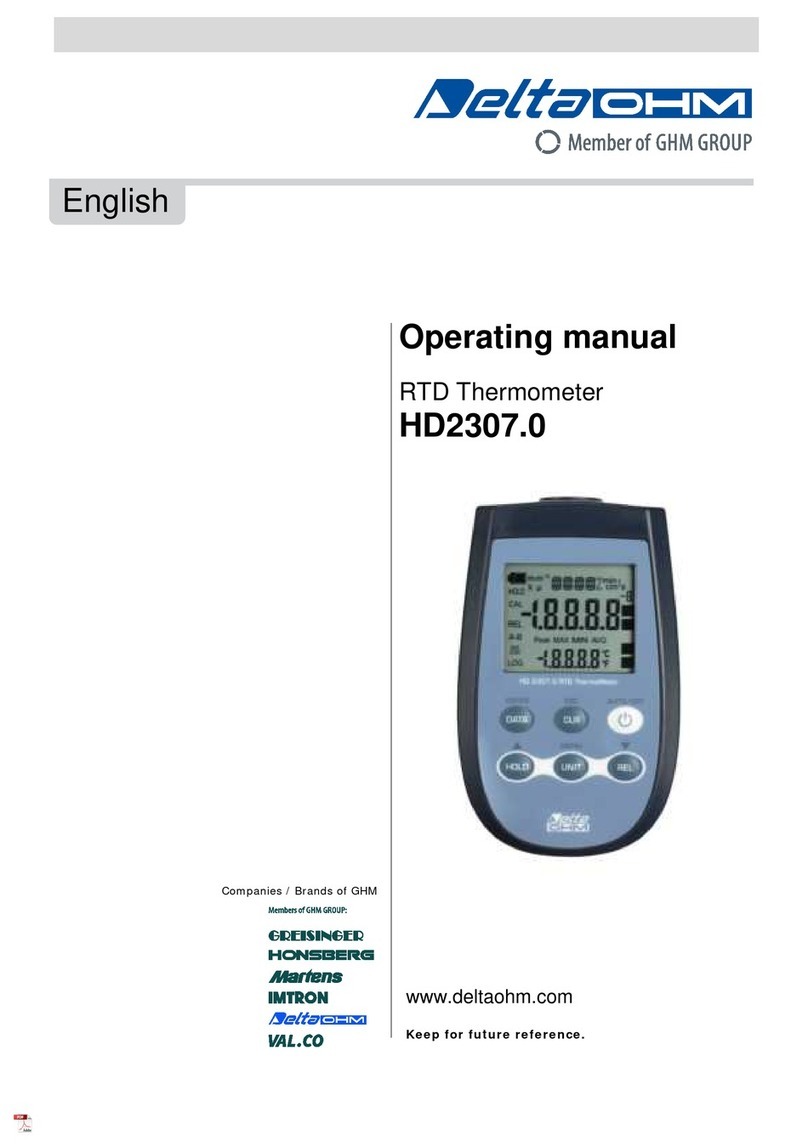
Delta OHM
Delta OHM HD2307.0 User manual

Delta OHM
Delta OHM HD2304.0 User manual
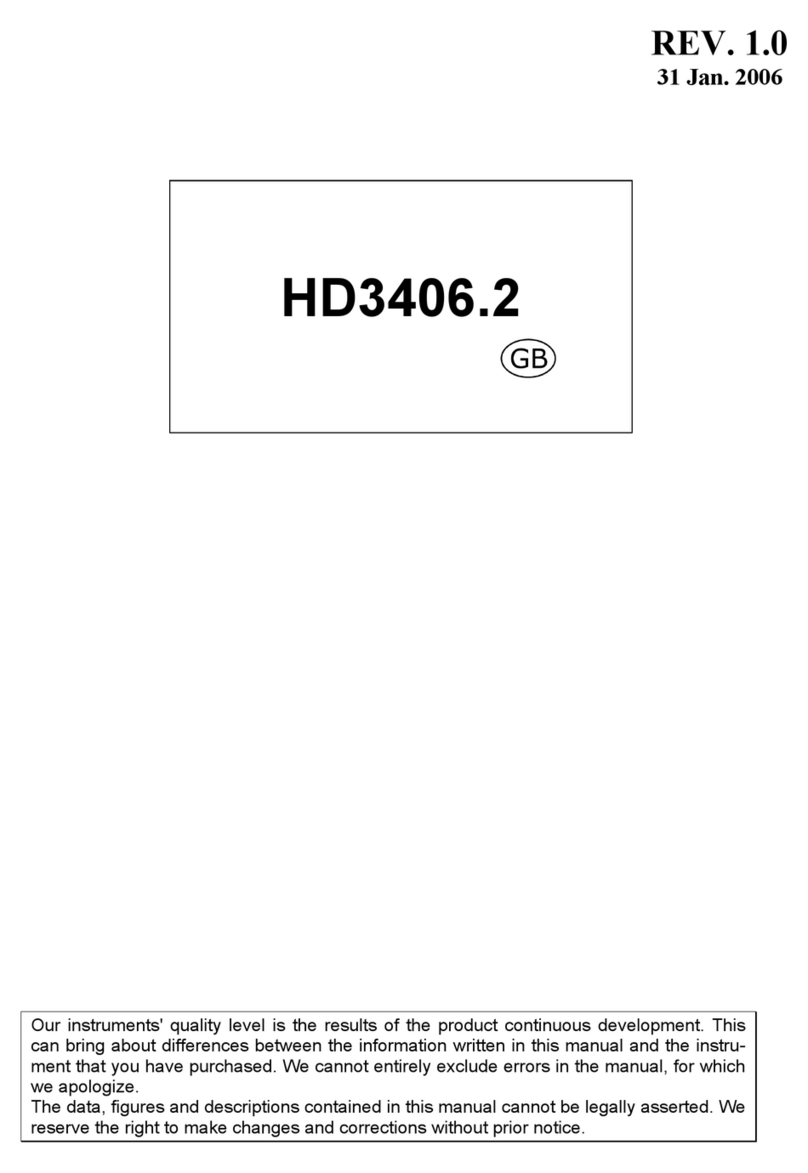
Delta OHM
Delta OHM HD3406.2 User manual

Delta OHM
Delta OHM HD2127.1 User manual
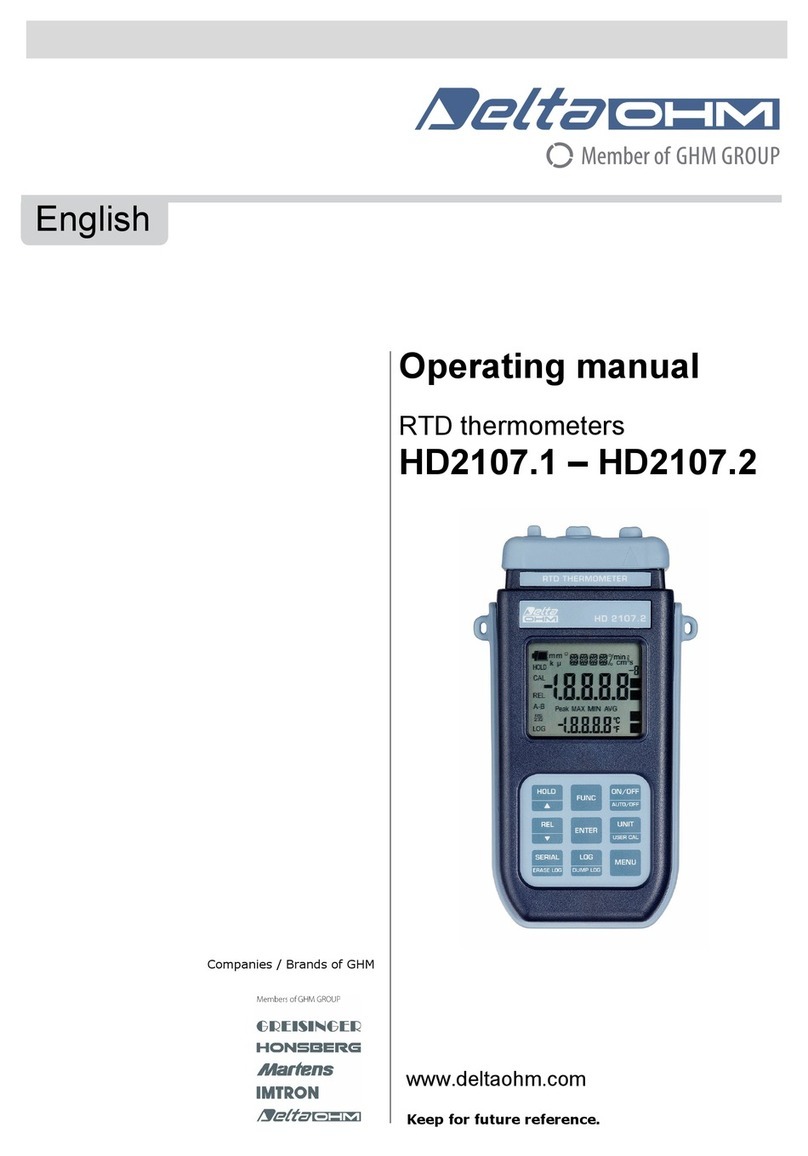
Delta OHM
Delta OHM HD2107.1 User manual
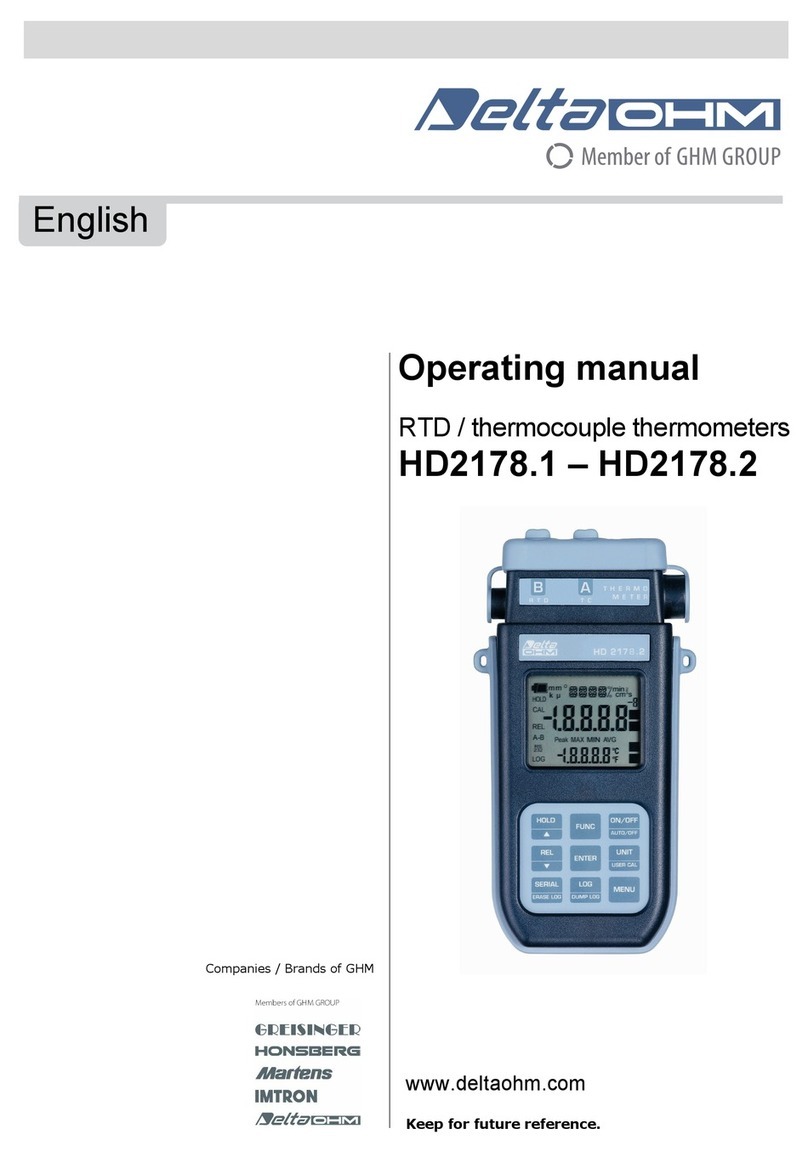
Delta OHM
Delta OHM HD2178.1 User manual

Delta OHM
Delta OHM HD 9212 User manual
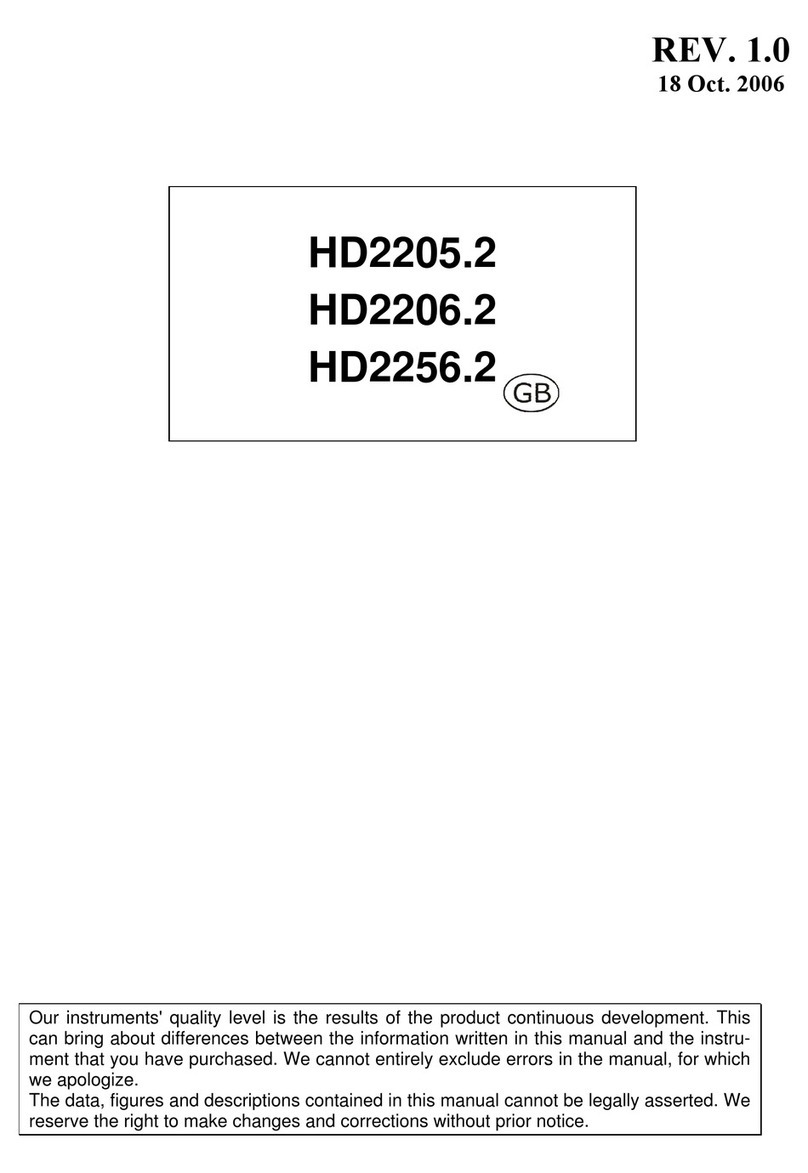
Delta OHM
Delta OHM HD2205.2 User manual

